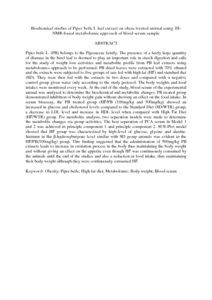Citation
Abdul Ghani, Zuleen Delina Fasya and Husin, Juani Mazmin and Ab Rashid, Ahmad Hazri and Shaari, Khozirah and Chik, Zamri
(2016)
Biochemical studies of Piper betle L leaf extract on obese treated animal using 1H-NMR-based metabolomic approach of blood serum sample.
Journal of Ethnopharmacology, 194.
pp. 690-697.
ISSN 0378-8741; ESSN: 1872-7573
Abstract
Piper betle L. (PB) belongs to the Piperaceae family. The presence of a fairly large quantity of diastase in the betel leaf is deemed to play an important role in starch digestion and calls for the study of weight loss activities and metabolite profile from PB leaf extracts using metabolomics approach to be performed. PB dried leaves were extracted with 70% ethanol and the extracts were subjected to five groups of rats fed with high fat (HF) and standard diet (SD). They were then fed with the extracts in two doses and compared with a negative control group given water only according to the study protocol. The body weights and food intakes were monitored every week. At the end of the study, blood serum of the experimental animal was analysed to determine the biochemical and metabolite changes. PB treated group demonstrated inhibition of body weight gain without showing an effect on the food intake. In serum bioassay, the PB treated group (HF/PB (100mg/kg and 500mg/kg) showed an increased in glucose and cholesterol levels compared to the Standard Diet (SD/WTR) group, a decrease in LDL level and increase in HDL level when compared with High Fat Diet (HF/WTR) group. For metabolite analysis, two separation models were made to determine the metabolite changes via group activities. The best separation of PCA serum in Model 1 and 2 was achieved in principle component 1 and principle component 2. SUS-Plot model showed that HF group was characterized by high-level of glucose, glycine and alanine. Increase in the β-hydroxybutyrate level similar with SD group animals was evident in the HF/PB(500mg/kg) group. This finding suggested that the administration of 500mg/kg PB extracts leads to increase in oxidation process in the body thus maintaining the body weight and without giving an effect on the appetite even though HF was continuously consumed by the animals until the end of the studies and also a reduction in food intake, thus maintaining their body weight although they were continuously consumed HF.
Download File
![[img]](http://psasir.upm.edu.my/55204/1.hassmallThumbnailVersion/Biochemical%20studies%20of%20Piper%20betle%20L%20leaf%20extract%20on%20obese%20treated%20animal%20using%201H-NMR-based%20metabolomic%20approach%20of%20blood%20serum%20sample.pdf)  Preview |
|
PDF (Abstract)
Biochemical studies of Piper betle L leaf extract on obese treated animal using 1H-NMR-based metabolomic approach of blood serum sample.pdf
Download (107kB)
| Preview
|
|
Additional Metadata
Actions (login required)
 |
View Item |

